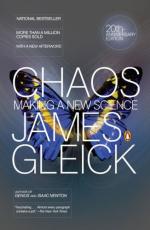
|
| Name: _________________________ | Period: ___________________ |
This test consists of 15 multiple choice questions and 5 short answer questions.
Multiple Choice Questions
1. Where was Mitchell Feigenbaum born?
(a) New York, New York.
(b) Hartford, Connecticut.
(c) Frankfort, Kentucky.
(d) Biloxi, Mississippi.
2. Albert Libchaber made the first experimental observation of the _____ that leads to chaos and turbulence in convective Rayleigh-Benard systems.
(a) Poincare conjecture.
(b) Fractal basin boundaries.
(c) No-slip condition.
(d) Bifurcation cascade.
3. What were used to address deep issues in theoretical physics according to the author in Chapter 8, "Images of Chaos"?
(a) Fluid dynamics.
(b) Period doubling bifurcation.
(c) Fractal basin boundaries.
(d) Thermodynamics.
4. In control theory, a system is _____ if any of the roots of its characteristic equation has real part greater than zero.
(a) Changing.
(b) Stable.
(c) Unstable.
(d) Unchanging.
5. What mathematical term refers to the Euclidean plane and three-dimensional space of Euclidean geometry, as well as the generalizations of these notions to higher dimensions?
(a) Boundary layer.
(b) Euclidean space.
(c) Gradient.
(d) Cantor dust.
6. In fluid dynamics, what consists of a viscous fluid confined in the gap between two rotating cylinders?
(a) Bifurcation cascade.
(b) The Taylor-Couette flow.
(c) Turbulent flow.
(d) Laminar flow.
7. Who along with Heinz-Otto Peitgen studied phase transitions, nonmagnetization and magnetization in materials and their picture of those boundaries showed the complex beauty that began to seem to natural?
(a) Feigenbaum.
(b) Mandelbrot.
(c) Kadanoff.
(d) Richter.
8. When did Mitchell Feigenbaum meet Michael Barnsley at a conference in Corsica?
(a) 1973.
(b) 1979.
(c) 1982.
(d) 1967.
9. What refers to a closed trajectory in phase space having the property that at least one other trajectory spirals into it either as time approaches infinity or as time approaches negative infinity?
(a) Fractal basin boundaries.
(b) Fractal compression.
(c) Limit-cycle.
(d) Period doubling bifurcation.
10. From what institution did Heinz-Otto Peitgen earn his Ph.D.?
(a) The Ecole Normale Supérieure.
(b) The University of Bonn.
(c) The University of Wisconsin-Madison.
(d) Johns Hopkins University.
11. What will drain rapidly from large-scale motions to small-scale motions?
(a) Viscosity.
(b) Fractal.
(c) Turbulence.
(d) Energy.
12. What is a concept in mathematics where a fixed rule describes the time dependence of a point in a geometrical space?
(a) Boundary layer.
(b) Dynamical system.
(c) Pattern formation.
(d) Oscillation.
13. Who is attributed with the following quote from Chapter 8, "Images of Chaos": "What else, when chaos draws all forced inward to shape a single leaf"?
(a) Conrad Aiken.
(b) Benoit Mandelbrot.
(c) Michael Barnsley.
(d) Albert Libchaber.
14. What refers to the static or animated 2-D or 3-D visual representation of information about software systems based on their structure, size, history or behavior?
(a) Fractal compression.
(b) Cosmic arrhythmias.
(c) Software metric.
(d) Software visualization.
15. Who is attributed with the following quote from Chapter 7, "The Experimenter": "It's an experience like no other experience I can describe, the best thing that can happen to a scientist, realizing that something that's happened in his or her mind exactly corresponds to something that happens in nature"?
(a) Leo Kadanoff.
(b) Conrad Aiken.
(c) Albert Libchaber.
(d) Michael Barnsley.
Short Answer Questions
1. What refers to systems whose behavior is intrinsically non-deterministic?
2. What refers to a physical science that studies the effects on material bodies, and on radiation in regions of space, of transfer of heat and of work done on or by the bodies or radiation?
3. According to the author, "to play the chaos game quickly, you need a computer with a graphics screen and a random number generator, but in principle a sheet of paper and" what will work as well?
4. When was Mitchell Feigenbaum offered a post at the Los Alamos National Laboratory in New Mexico to study turbulence in fluids?
5. What is defined as a mess of disorder on all scales and is not stable?
|
This section contains 571 words (approx. 2 pages at 300 words per page) |

|




